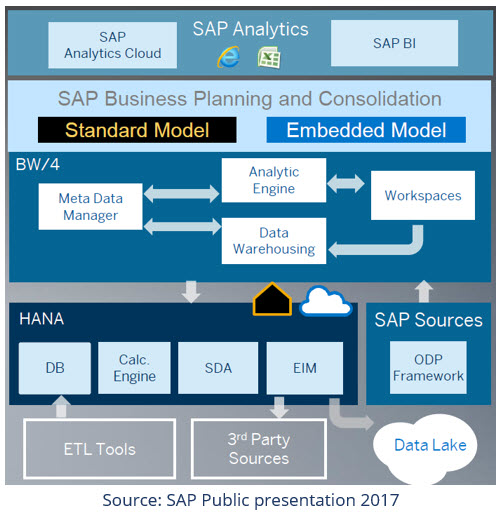SAP BPC 11.0 is the last version of the SAP tool for Planning and Consolidation, specifically the Service Pack 07 is the last one, released on 17.12.2018. The last months we have seen several news that involve SAP BPC, the main one is that on SAP S/4HANA it won’t be the strategic product for Consolidation, this one will be the Group Reporting tool (for Planning SAP BPC Optimized for S/4HANA is still the strategic one). But it seems that the version 11 for SAP BW/4HANA is the recommended by SAP for standalone On-Premise deployments for Planning and also for Consolidation. We can see the following flowchart to take a decision:


Once we are decided for the solution SAP BPC 11.0, it is time to decide the model, which means Standard or Embedded. Both are included in the tool. There isn’t a formula to decide it, but generally when the customer wants an integrated planning tool to manage it in the decentralized way, we should choose Embedded. On the other hand, if the customer wants that the users are autonomous creating dimension members and modifying the model, we should choose the Standard one. The good news here is that we can have projects in both versions (Embedded and Standard) in the same system. There are some other things to take in consideration in order to choose the version, like the following:
What can we expect from SAP BPC 11?
We will find a solution:
- for planning and consolidation together (now the functionalities of BI-IP and PAK are included in Embedded), what SAP has called “Simplicity”,
- that integrates data from cloud systems, like SAP Analytics Cloud, and Third-Party data (SAP BPC in the cloud with AWS, SAP HEC, and other cloud platforms), what SAP called “Openness”,
- with a Modern Interface that includes a new Homepage and navigation (following the SAP Fiori 2.0 design as a harmonized design), and simplified models to plan in BW/4HANA,
- with fewer calculations by HANA query and thus losing less time per cycle and an improved scalability to plan with greater detail,
With SAP BPC 11 we will find the balance between Flexibility and Integration, which means the tool covers many functionalities that will give the “Freedom” for the end users, but also the possibility of a high integration.

Architecture
In the following picture we can see the Architecture of SAP BPC 11.0:

The conclusions we can extract from the picture are already mentioned in the previous lines, concepts like:
- both, Standard and Embedded Model, are included,
- BW-PAK and BI-IP are part of the functionality included in BPC BW/4HANA,
- deployments in different clouds, like HEC, AWS, Azure or Virtustream is allowed,
SAP BPC 11.0, version for BW/4HANA with S/4HANA and BW/4HANA
How can we integrate features of S/4HANA in a SAP BPC 11.0, version for BW/4HANA, project?
The concepts of BW/4HANA and S/4HANA are completely different and complementary. On the one hand we have S/4HANA with an “Embedded BW” which includes BPC 10.1 NW as planning and consolidation engine. And on the other hand we have SAP BW/4HANA with a SAP BPC version for BW/4HANA add-on installed. BW/4HANA is a Data Warehouse that can consolidate data from different sources (SAP and non-SAP) and S/4HANA is an ERP suite designed specifically for in-memory computing

Then to work with the combination of both we will use 2 separate systems as we can see in the previous picture.
Hybrid Scenario integration with SAP Analytics Cloud for planning
With all characteristics of SAP BPC I’ve detailed, we can consider it as a good solution for planning and consolidation that takes the advantage of using Excel usability to give a lot of flexibility to the users, who are using it from their PCs. But what about the ones who are out of the office? We should consider the new options that the cloud applications give us, like:
- Access to the information from everywhere.
- Graphic Visualizations: Dashboards.
- What-if simulations.

SAP Analytics Cloud can increase the value of BPC, since we can import and export BPC data, the users are able to create their own analyzes and they can simulate changes without modifying in the original master data.
